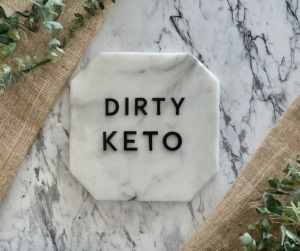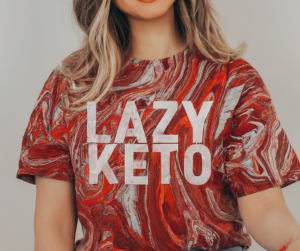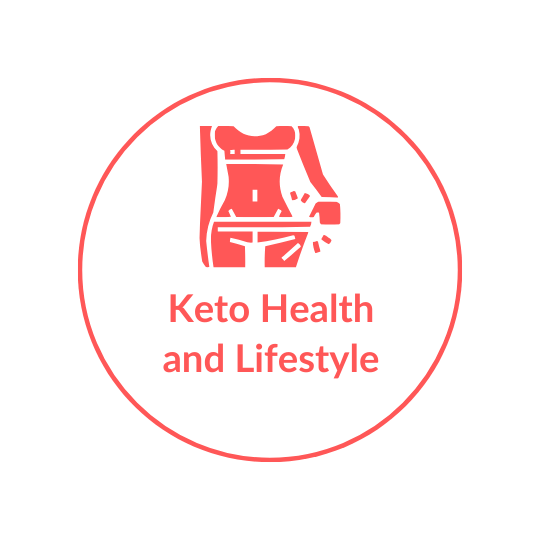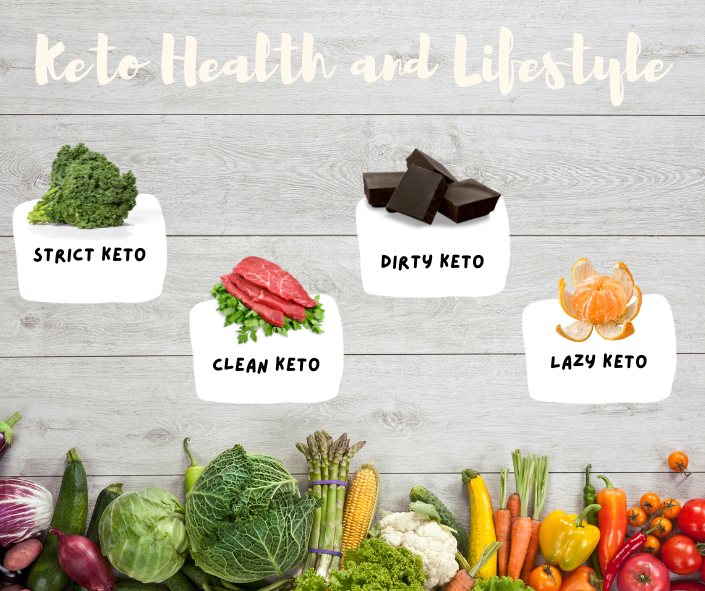This post may contain affiliate links which means I may receive a commission for purchases made through links. Learn more about policies on my about page.
Table of Contents
Introduction
The keto diet (called by some ‘dirty lazy keto’) is a low-carb, high-fat diet that aims to shift the body into a state of ketosis, where it burns fat for fuel instead of carbohydrates. There are different variations of the keto diet, including strict keto, clean keto, dirty keto and lazy keto.
The ketogenic diet, often referred to as the keto diet, is a dietary approach that focuses on consuming low amounts of carbohydrates and high amounts of fat. This forces the body to enter a metabolic state called ketosis, where it primarily burns fat for energy instead of glucose. Various types of the keto diet exist, including strict keto, clean keto, dirty lazy keto, each with its own guidelines and restrictions. Most people incorporate intermittent fasting alongside whichever style of the Keto Diet they are following.
Strict Keto

What is strict Keto?
A. Strict keto is a dietary approach that aims to achieve and sustain a state of ketosis as its primary goal.
B. Strict keto follows key principles and rules, including strict macronutrient ratios with high fat intake, moderate protein intake, and very low carb intake.
C. Benefits of strict keto include potential weight loss and improved metabolic health, such as better blood sugar control and increased fat burning.
D. Potential drawbacks and challenges of strict keto include the need for meticulous tracking of food intake and potential nutrient deficiencies due to limited food choices.
Strict Keto food list
Good foods for strict keto:
- Meat (such as beef, pork, lamb, and poultry)
- Fish and seafood
- Eggs
- Natural fats and oils (like butter, coconut oil, and olive oil)
- Non-starchy vegetables (such as spinach, kale, broccoli, and cauliflower)
- Cheese and other dairy products (in moderation)
Foods to avoid on strict Keto:
- Grains (including bread, pasta, rice, and oats)
- Sugary foods and drinks (such as candy, soda, and fruit juices)
- Starchy vegetables (like potatoes and corn)
- Most fruits (except for small portions of berries)
- Legumes (such as beans, lentils, and chickpeas)
- Processed foods and snacks containing added sugars or carbs
Note: It’s important to consult with a healthcare professional or a registered dietitian before making any significant changes to your diet.
Clean Keto

What is clean Keto?
A. Clean keto focuses on consuming whole, unprocessed foods.
B. Emphasis is placed on the quality of food sources, including organic and sustainably sourced options.
C. Clean keto offers benefits such as improved nutrient intake and overall health.
D. Potential drawbacks include higher cost and limited food options in certain situations.
Clean Keto food list
Good foods for clean Keto:
- Avocado
- Leafy greens (spinach, kale)
- Nuts and seeds (almonds, pumpkin seeds)
- Lean meats (chicken, turkey)
- Fatty fish (salmon, sardines)
- Coconut oil
- Olive oil
Bad foods for clean Keto:
- Grains (rice, wheat)
- Sugary fruits (bananas, grapes)
- Starchy vegetables (potatoes, corn)
- Processed foods (chips, cookies)
- Sugary drinks (sodas, fruit juices)
- High-carb condiments (ketchup, barbecue sauce)
Please note that individual dietary needs may vary. It’s always best to consult with a healthcare professional or registered dietitian for personalized advice.
Dirty Keto

What is dirty Keto?
A. Dirty keto is a variation of the ketogenic diet that places less emphasis on the quality of food consumed. It allows for a more relaxed approach towards food quality, often allowing processed and less healthy food choices.
B. The primary focus of dirty keto is on meeting macronutrient goals, such as consuming a high fat, low carbohydrate diet, rather than prioritizing the quality of the food sources. This approach allows for more flexibility in food choices, including processed and less healthy options.
C. Benefits of dirty keto include increased flexibility and convenience in meal planning, as it allows for a wider range of food choices. This can be helpful for individuals with busy lifestyles or those who struggle with strict dietary restrictions.
D. However, it’s important to note that dirty keto may have potential drawbacks. By allowing for processed and less healthy food choices, it may have a negative impact on overall health. Additionally, it may lead to nutrient deficiencies if whole, nutrient-dense foods are not prioritized in the diet.
Dirty Keto food list
Good foods for dirty Keto:
- Fatty meats
- Cheese
- Eggs
- Butter
- Oils
- Avocados
- Nuts
- Seeds
Bad foods for dirty Keto:
- processed meats
- Sugury snacks
- grains
- Starchy vegetables
- Fruits
- Most dairy products
Lazy Keto

What is lazy Keto?
A. Lazy keto is a simplified approach to tracking macronutrients on a ketogenic diet.
B. Lazy keto focuses primarily on monitoring carbohydrate intake while being less strict about tracking other macros.
C. Benefits of lazy keto include ease of adherence and simplicity in comparison to strict tracking methods.
D. Potential drawbacks of lazy keto include slower progress and the possibility of overconsuming calories.
Lazy Keto food list
Good foods for lazy Keto:
- Eggs
- Avocados
- Nuts and seeds (almonds, walnuts, chia seeds)
- Olive oil and coconut oil
- Fatty cuts of meat (beef, pork, lamb)
- Cheese and full-fat dairy products
- Leafy green vegetables (spinach, kale)
- Berries (strawberries, blackberries)
Bad foods for lazy Keto:
- Sugary beverages (sodas, fruit juices)
- Processed snacks and sweets
- Grains and starchy foods (bread, rice, potatoes)
- High-carb fruits (bananas, grapes, mangoes)
- Vegetable oils (canola oil, soybean oil)
- Legumes (beans, lentils)
- Low-fat or fat-free products
Please note that lazy keto focuses on limiting carbs, so the emphasis should be on consuming foods low in carbohydrates and high in healthy fats.
Conclusion – Strict Keto vs Clean Keto vs Dirty Keto vs Lazy Keto
Strict, clean, dirty, and lazy keto are different variations of the popular ketogenic diet. Each variation has its own unique characteristics and guidelines. Strict keto involves closely monitoring macronutrient intake, aiming for a high fat, moderate protein, and low carbohydrate diet. Clean keto emphasizes consuming whole, unprocessed foods and avoiding artificial additives. Dirty keto focuses solely on macronutrient ratios and allows for more flexibility in food choices, including processed and fast foods. Lazy keto simplifies the tracking process by primarily monitoring carbohydrate intake, while being less strict about other macronutrients.
When choosing a keto approach, it is important to consider your own goals, preferences, and lifestyle. Strict keto may be suitable for individuals who require precise macronutrient control and are dedicated to a disciplined eating routine. Clean keto may be a better fit for those who prioritize whole food choices and want to embrace a healthier lifestyle. Dirty keto can be an option for individuals who prioritize convenience and flexibility. Lastly, lazy keto may be appealing to those who want to simplify their tracking process while still achieving some benefits of the ketogenic diet.
Ultimately, the choice of which variation to follow depends on your personal preferences and goals. It’s important to find an approach that you can sustain in the long term and that aligns with your individual needs. Start off with an initial weigh in to measure your body fats and BMI. Remember to consult with a healthcare professional or registered dietitian before making any significant changes to your diet.

